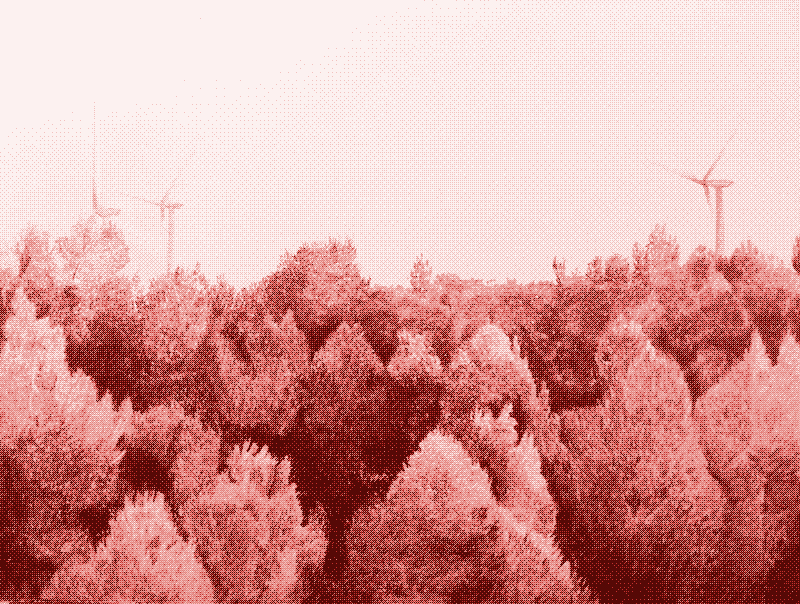
For more than two thousand years, windmills were built from recyclable or reusable materials: wood, stone, brick, canvas, metal. When – electricity producing – wind turbines appeared in the 1880s, the materials didn’t change. It’s only since the arrival of plastic composite blades in the 1980s that wind power has become the source of a toxic waste product that ends up in landfills.
New wood production technology and design makes it possible to build larger wind turbines almost entirely out of wood again – not just the blades, but also the rest of the structure. This would solve the waste issue and make the manufacturing of wind turbines largely independent of fossil fuels and mined materials. A forest planted in between the wind turbines could provide the wood for the next generation of wind turbines.
How Sustainable is a Windmill Blade?
Wind turbines are considered to be a clean and sustainable source of power. However, while they can indeed generate electricity with lower CO2-emissions than fossil fuel power plants, they also produce a lot of waste. This is easily overlooked, because roughly 90% of the mass of a large wind turbine is steel, mainly concentrated in the tower. Steel is commonly recycled and this explains why wind turbines have very short energy payback times – the recycled steel can be used to produce new wind turbine parts, which greatly lowers the energy required during the manufacturing process.
However, wind turbine blades are made from light-weight plastic composite materials, which are voluminous and impossible to recycle. Although the mass of the blades is limited compared to the total mass of a wind turbine, it’s not negligible. For example, one 60 m long fiberglass blade weighs 17 tonnes, meaning that a 5 MW wind turbine produces more than 50 tonnes of plastic composite waste from the blades alone.
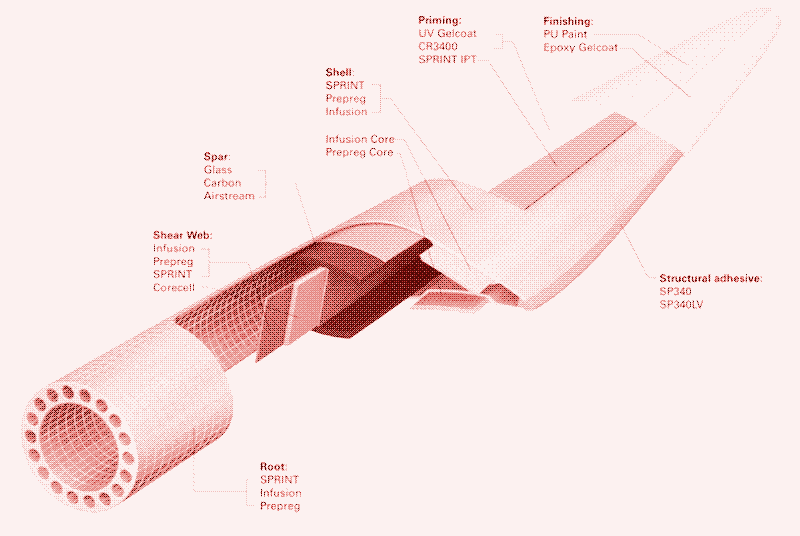
A windmill blade typically consists of a combination of epoxy – a petroleum product – with fiberglass reinforcements. The blades also contain sandwiched core materials, such as polyvinyl chloride foam, polyethylene terephtalate foam, balsa wood (intertwined in fibers and epoxy) and polyurethane coatings. 1234
Unlike the steel in the tower, the plastic in blades cannot be recycled to make new plastic blades. The material can only be “downcycled”, for instance by shredding it, which damages the fibers and makes them useless for anything but a filler reinforcement in cement or asphalt production. Other methods are being investigated, but they all run into the same problem: nobody wants the “recycled” material. Some architects have re-used windmill blades, for example to build benches or playgrounds. But we cannot build everything out of wind turbine blades.
A 5 MW wind turbine contains more than 50 tonnes of unrecyclable plastic in the blades alone.
Because of the limited options for recycling and re-use, windmill blades are usually landfilled (in the US) or incinerated (in the EU). The latter approach is not less unsustainable, because incinerating the blades only partially reduces the amount of material to be landfilled (60% of the scrap remains as ash) and converts the rest into air pollution. Furthermore, given that fiberglass is incombustible, the caloric value of the blades is so limited that little or no power can be produced. 1234
Dealing With Waste – 25 Years Later
Most of the roughly 250,000 wind turbines now in operation worldwide were installed less than 25 years ago, which is their estimated life expectancy. However, the rapid growth of wind power over the last two decades will soon be reflected in a delayed but ever increasing and never-ending supply of waste materials.
For example in Europe, the share of installed wind turbines older than 15 years increases from 12% in 2016 to 28% in 2020. In Germany, Spain and Denmark, their share increases to 41-57%. In 2020 alone, these countries will each have to dispose of 6,000 to 12,000 wind turbine blades. 5
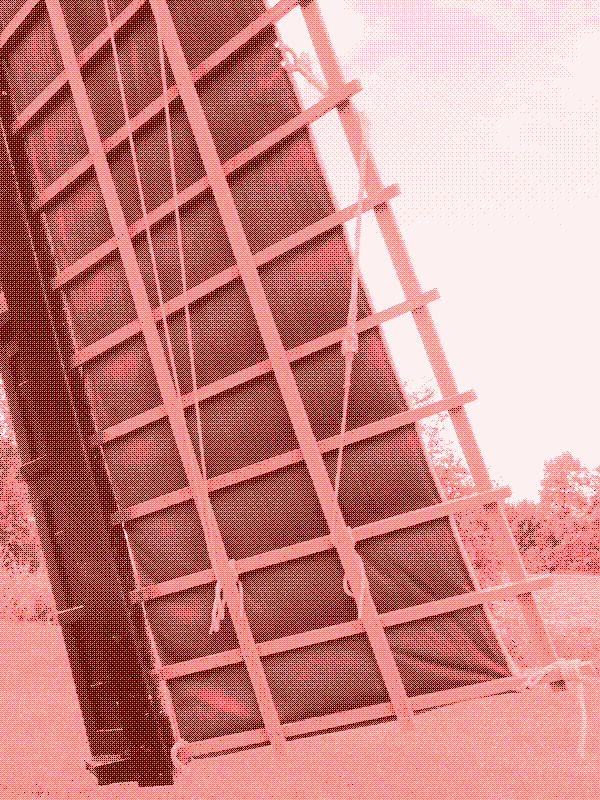
Discarded blades will not only become more numerous but also larger, reflecting a continuous trend towards ever larger rotor diameters. Wind turbines built 25 years ago had blade lengths of around 15-20 m, while today’s blades reach lengths of 75-80 m or more. 3 Estimates based on current growth figures for wind power have suggested that composite materials from blades worldwide will amount to 330,000 tonnes of waste per year by 2028, and to 418,000 tonnes per year by 2040. 1
The rapid growth in wind power over the last two decades will soon be reflected in a delayed but ever increasing and never-ending supply of waste materials.
These are conservative estimates, because numerous blade failures have been reported, and because constant development of more efficient blades with higher power generating capacity is resulting in blade replacement well before their estimated lifespan. 16 Furthermore, this amount of waste results from wind turbines installed between 2005 and 2015, when wind power only supplied a maximum of 4% of global power demand. If wind would supply a more desirable 40% of (current) power demand, there would be three to four million tonnes of waste per year.
Windmill Blades Through History
Yet a look at the history of wind power shows that plastic is not an essential material. The use of wind for mechanical power production dates back to Antiquity, and the first electricity generating windmills – now called wind turbines – were built in the 1880s. However, fiberglass blades only took off in the 1980s. For some two thousand years, windmills of whatever type were entirely recyclable.
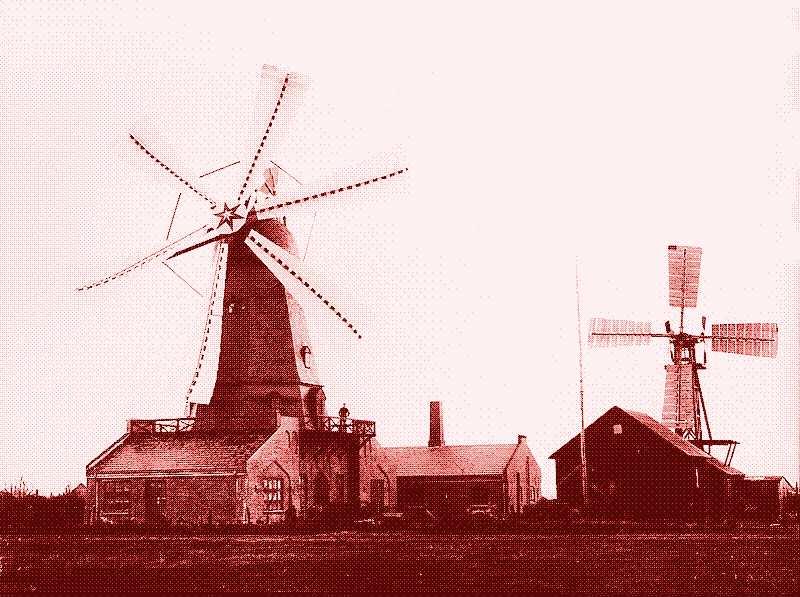
Old-fashioned windmills had towers built out of wood, stone, or brick. Their “blades” or “sails” were usually made of a wood framework covered with canvas or wood boards. In later centuries, parts were increasingly made from iron, also a recyclable material.
When new types of sails were invented in the eighteenth and nineteenth centuries (such as spring, patent, and rolling-reefer sails), as well as in the twentieth century (Dekkerized and Bilau sails), the design changed but the materials remained the same (eventually including aluminum). 7 Furthermore, contrary to modern wind turbines, which need to be replaced regularly and in their entirety, old-fashioned windmills could last for many decades or even centuries through regular repair and maintenance.
A look at the history of wind power shows that plastic is not an essential material.
The first wind turbine in the US, built by Charles F. Brush, had a 17 m diameter annular sail with 144 thin blades made of cedar wood. The first wind turbine in Europe, built by Paul La Cour in Denmark, had four traditional slatted wooden sails with a rotor diameter of 22.8 m.
La Cour’s design was copied by local enterprises in Denmark, resulting in thousands of wind turbines operating on Danish farms between 1900 and 1920. Dozens of experimental wind turbines were built during the first half of the twentieth century, including some with steel blades, such as the 1939 Smith-Putnam wind turbine in the US. 8
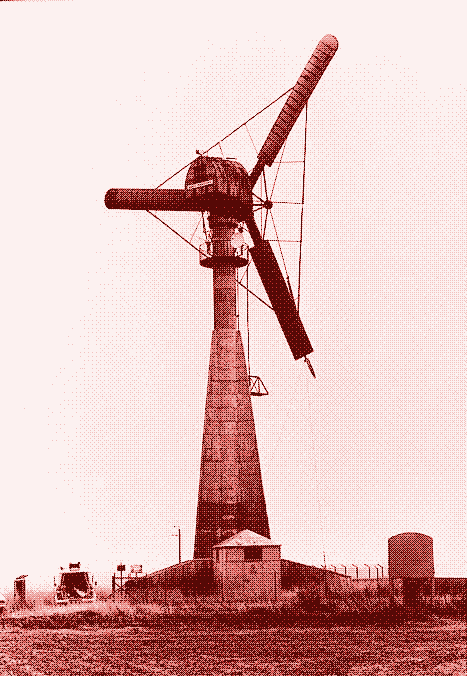
In 1957, Johannes Juul – a student of Paul La Cour – built the three-bladed Gedser wind turbine. It had a rotor diameter of 24 m and relied on an air frame superstructure of steel wires for rotor and blade stiffening. The blades were built from steel spars, with aluminium shells supported by wooden ribs.
The Gedser turbine remained the most successful wind turbine until the mid-1980s. It ran for 11 years without maintenance, generating up to 360,000 kWh per year, but was not repaired when a bearing failed. When the turbine was refurbished and tested in the late 1970s, it performed better than the first wind turbines with fiberglass blades. 89
Size Matters
The first wind turbine with fiberglass blades was installed in 1978 in Denmark, where it powered a school. With its 54 m diameter rotor, the Tvind turbine was at the time the largest wind turbine ever built. After 1980, fiberglass blades became standard in Denmark and the “Danish design” was later copied all over the world. The plastic blade, so it seems, is what defines the modern wind turbine. This presents us with a dilemma.
The switch to fiberglass blades was mainly driven by the desire to build larger wind turbines. Larger wind turbines lower the cost per kilowatt-hour of generated electricity, for two reasons: the wind increases with height, and the doubling of the rotor radius increases power output four times.
The desire to build larger wind turbines has driven the wind industry ever since. Rotor diameters increased from around 50 m in the 1990s to 120 m in the 2000s. Today’s largest off-shore wind turbines have rotor diameters of more than 160 m, and a 12 MW turbine with a 220 m rotor diameter is being constructed in the Netherlands. 3610
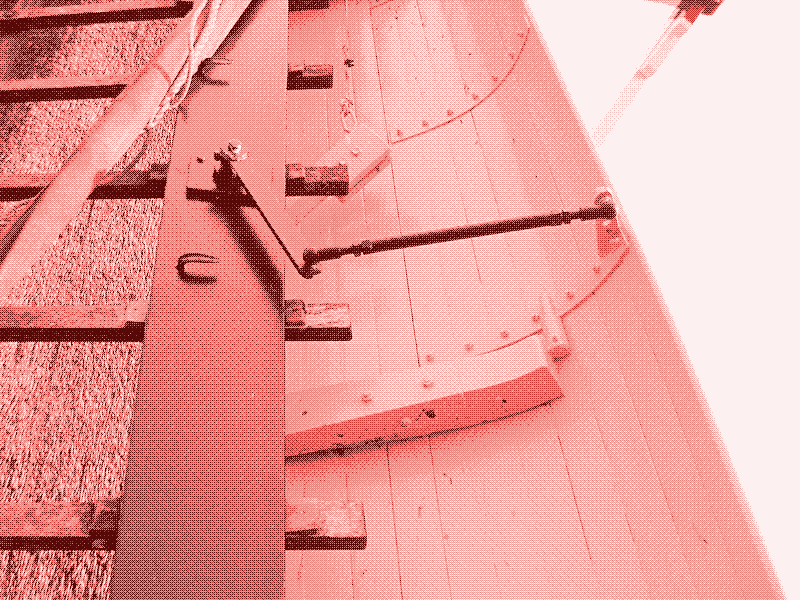
However, with increasing size, the mass of the rotor blade also increases, which requires lighter materials. At the same time, larger blades deflect more, so that their structural stiffness is of increasing importance to maintain optimal aerodynamic performance and to avoid the blade hitting the tower. In short, larger wind turbines with longer blades place ever higher demands on the materials used, and these exceed the capacities of recyclable materials. 1112 Wind turbines have become more efficient, but also less sustainable.
Larger wind turbines with longer blades place ever higher demands on the materials used.
Right now, this trend is illustrated by the increasing use of carbon fiber reinforced plastic, which is even stronger, stiffer and lighter than fiberglass reinforced plastic. 11 The use of carbon fibers – which further complicates potential recycling – has become standard in the largest wind turbine blades, mainly in highly stressed locations such as the blade root or the spar caps. Consequently, we have again entered a new era in which blades are now so large that they cannot be made out of fiberglass reinforced composites alone anymore.
Reinventing the Windmill Blade
An industry that calls itself sustainable and renewable cannot send millions of tonnes of plastic waste to landfills each year. Consequently, could we revert to building wind turbine blades from recyclable materials alone? And how large could we build them? To which extent can efficiency and sustainability be reconciled?
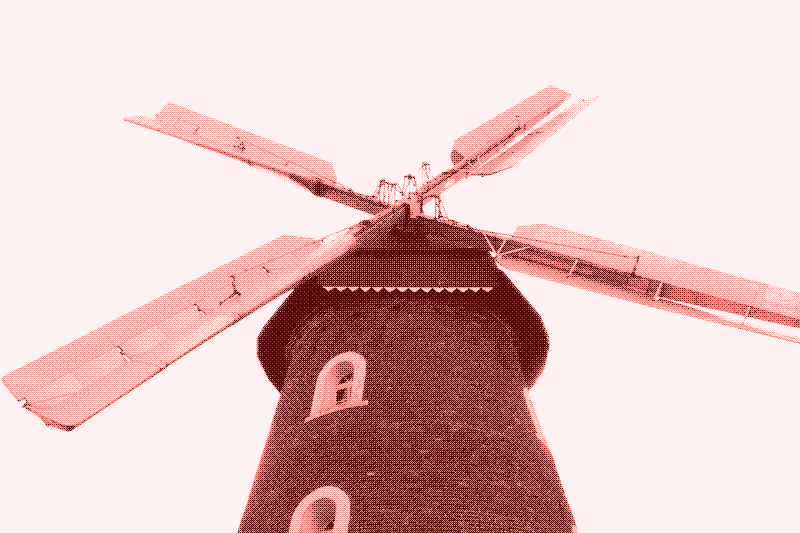
Most research into the design of more sustainable wind turbine blades sticks with plastic as the main material. Thermoplastics can be melted and re-used, making it possible to recycle the blades into new wind turbine blades, even on-site. However, due to the material’s lower strength and stiffness, these blades have not been built larger than 9 m for now. 113
Another area of development is the substitution of glass fibers for wood or flax fibers. These blades can be larger, but they have only small sustainability advantages over fiberglass-epoxy blades. 1415 The petroleum-based epoxy is more harmful than the glass fiber, and natural fiber based composite materials absorb more of it. 161712
The length of wood blades is no longer limited by the availability of large tree trunks of consistent quality.
Some engineers and scientists follow different paths and revert to more traditional wood construction. For small wind turbines, blades can be carved out of solid wood. For larger wind turbines, the blades can be composed of a hollow aerodynamic shell and an internal framework of ribs and stringers supported by a beam called the spar – all built from laminated veneer wood boards, beams and panels.
Laminated Veneer Lumber
Laminated veneer lumber – in which the wood is peeled off the tree and then glued back together in thin layers – is a wood product that appeared in the 1980s, and which has an important advantage in relation to solid wood components. The consistency of wood can vary within a single tree. Therefore, the length of the wood spars used in pre-industrial windmills was limited by the availability of large tree trunks of consistent quality. The largest traditional windmill ever built – the 1900 Murphy mill in San Francisco – had a rotor diameter of 35 m.
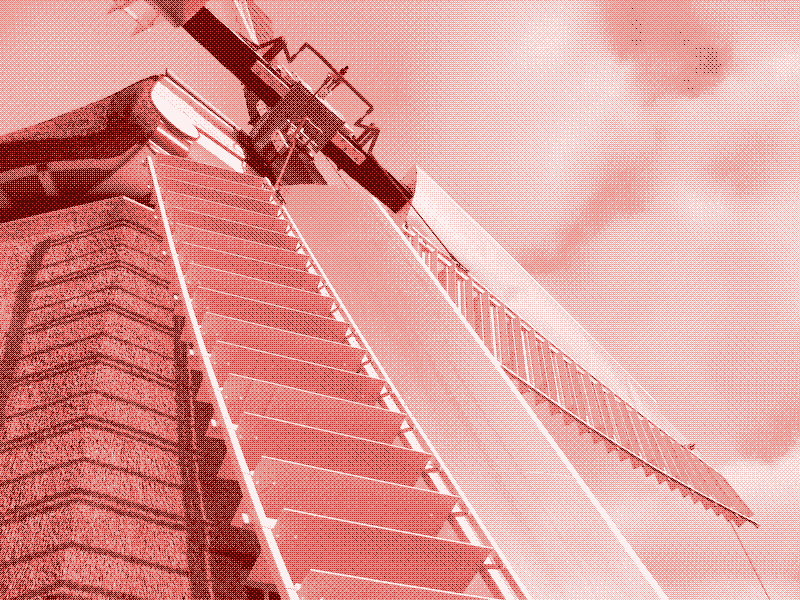
In contrast, the process of veneering spreads out defects such as knots, giving better and more predictable stiffness properties. This allows to build larger wooden blades. 12 Wood laminates offer substantial cost and weight reductions as compared to fiberglass. Although the strength and stiffness are lower, much of the load that the blade must support is a consequence of its own weight, so a wood blade doesn’t need to be as strong as a fiberglass blade. 12 Nevertheless, the low stiffness of wood makes it difficult to limit the elastic deflections for very large rotor blades.
In a 2017 study of a 5 MW wind turbine with 61.5 m long blades, conducted at UMassAmherst in the US, it was calculated that in order to be stiff enough and withstand the forces that it’s exposed to, a blade made of laminated wood veneer panels would be 2.8 heavier than a plastic blade (48 versus 17 tonnes) and have a laminate of over 50 cm thick. 12 Although this suggests that it’s technically possible to build a wooden blade more than 60 m long, it’s not very practical. With heavier blades, the wind turbine needs to be built much stronger, which increases the costs and the use of resources.
Best of Both Worlds?
There’s two ways to solve this problem. The first is to design a blade largely made from laminated veneer lumber, but reinforced with carbon composite spars and covered with an outer layer of fiberglass composite. In the above mentioned study it was found that such a wood-carbon hybrid blade is stiff enough to reach a length of 61.5 m for a 5 MW turbine, and can be built 3 tonnes lighter than a fiberglass blade. 12 Another study for a wood-carbon blade of the same length comes to a similar conclusion, although in this case the wood-carbon blade is slightly heavier than the plastic blade. 14
A blade largely made from laminated veneer lumber, but reinforced with carbon composite spars, can be built more than 60 metres long.
Wood-carbon blades contain less plastic composite material, and the plastic is not intertwined with wood throughout the blade but clearly separated from it, making blade re-use, recycling or incineration more attractive. However, according to the studies mentioned above, a wood-carbon blade still contains 2.5 tonnes 14 to 6.2 tonnes 12 of plastic composites, meaning that a three-bladed 5 MW wind turbine would produce 7.5 to 18.4 tonnes of unrecyclable waste – compared to 50 tonnes for a conventional blade.
Smaller Wind Turbines?
The environmental damage of the carbon-epoxy spars can be viewed as acceptable, if compared to the larger damage done by conventional wind turbine blades. However, the waste problem would not be solved, and further growth in wind power would still result in ever larger waste streams.
![Image: A laminated wooden blade with carbon spar caps. Source: [^14]](https://solar.lowtechmagazine.com/2019/06/how-to-make-wind-power-sustainable-again/images/dithers/carbon-spar-caps_dithered.png)
Alternatively, we could define sustainability in more ambitious terms, and build wind turbine blades completely out of wood again – even if this means that we have to build them smaller. There’s an extra argument to question our focus on efficiency: the decrease in sustainability not only shows in the blades. Other parts of wind turbines are also increasingly made from plastic composites – most notably the nose cone and the nacelle cover (the housing that protects the drivetrain and the auxiliary equipment from the elements). 1234
Other trends are the increased use of electronics, which are not suited for recycling, and of permanent magnet generators based on rare earth materials, which save costs compared to a mechanical gearbox but only at the expense of more destructive mining. Larger wind turbines also kill more birds and bats. 18
By sacrificing some efficiency, we could gain a lot in sustainability.
By sacrificing some efficiency, we could gain a lot in sustainability. Wind power advocates may not agree, because it would make wind power less competitive with fossil fuels. However, more expensive wind power can always be counteracted by higher prices for fossil fuels.
What’s really problematic is our choice of cheap fossil fuels as a benchmark to determine the viability of wind power. It’s by aiming to compete with fossil fuels – and thus by aiming to provide the energy for a lifestyle built on fossil fuels – that wind turbines have become increasingly damaging to the environment. If we would reduce energy demand, smaller and less efficient wind turbines would not be a problem.
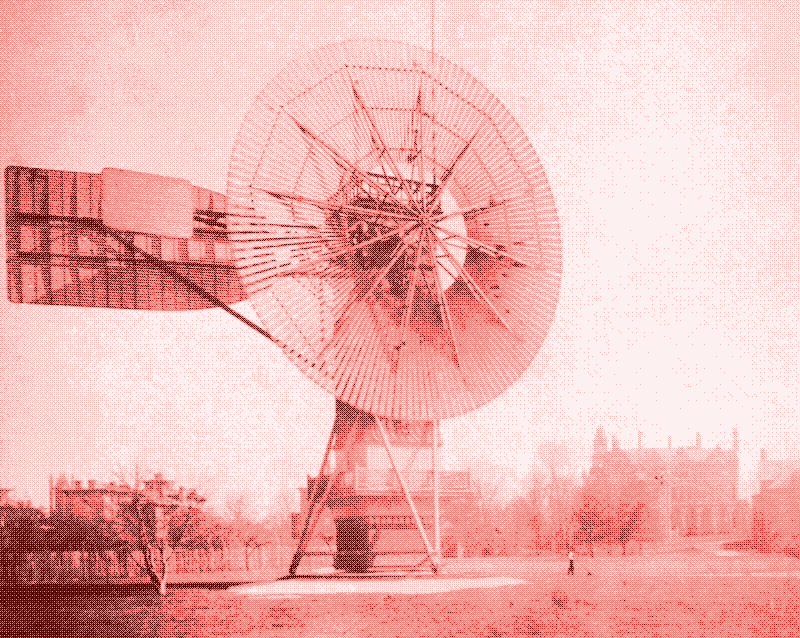
How large could we build practical wind turbine blades from laminated veneer lumber alone? Nobody seems to know. I asked Rachel Koh, the scientist who calculated the requirements for the 61.5 m wood-only blade, but she couldn’t help me: “I only ran the model for the blades of a 5 MW turbine. It would be hypothetically possible to run another study to answer your question, but it’s not a small undertaking”. She also notes that it’s possible to further improve the stiffness of wood laminates with manufacturing innovations.
A Forest of Wind Turbines
Whether we opt for large wood-carbon blades or smaller wood-only blades, in both cases we could also build the tower and the nacelle cover from laminated wood products. In 2012, the German company TimberTower built a laminated wood tower 100 m tall for a 1.5 MW wind turbine. A wooden tower seems to be besides the point, because it replaces part of a wind turbine that’s already perfectly recyclable. However, a wind turbine of which the structure is almost completely built out of wood offers extra benefits.
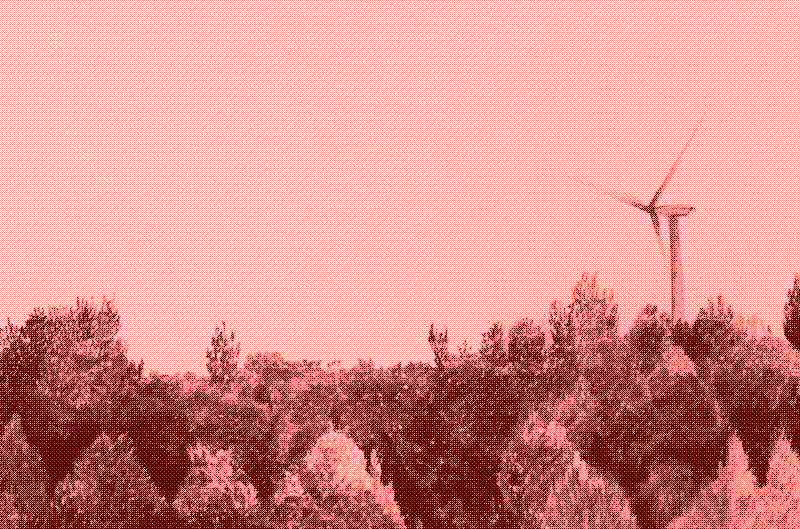
Wood could make the production of wind turbines entirely independent of mined materials and of fossil fuels, except for the gearwork and the electric components (but further gains can be achieved, whenever possible, by using wind power for direct mechanical). 19 Furthermore, wooden wind turbines could become a carbon sink – sequestering CO2 from the atmosphere in their wood components.
Finally, the space between wind turbines on a wind farm, which is not suited as a residential area, could be used to grow a forest that would provide the wood for the next generation of wind turbines. The lumber could be sawed, processed and assembled on-site, which eliminates the energy use associated with the transport of wind turbine parts. The energy required for manufacturing the laminates and for constructing the turbines could come from the windmills, as well as from forest biomass. Especially if blades are made of wood only, the wind turbine could become a textbook example of the circular economy.
What about solar panels?
A forthcoming article investigates the sustainability of solar panels. Is toxic and unrecyclable waste inherent to solar PV power? Could we build solar panels using sustainable materials? And what would that mean for the affordability and efficiency of solar power?
Reactions
To make a comment, please send an e-mail to solar (at) lowtechmagazine (dot) com. Your e-mail address is not used for other purposes, and will be deleted after the comment is published. If you don’t want your real name to be published, sign the e-mail with the name you want to appear.
Reactions
Michael Dowling
I find it incredible when I read that a 60m plastic composite blade weighs 17 tonnes! 1700 kg, yes, but 17 tonnes! I can see how old blades would be a recycling problem.
H
Do you know this type of wind turbine?
http://www.eolienne-a-depression.fr/index.php?option=com_content&view=article&id=54&Itemid=54
Kris De Decker
@ ijk-ijk
That’s a very good question. It was calculated that the first fiberglass blades from the late 1970s had a life expectancy of 70 years. (And the same was true for the wood-alu blades from the Gedser turbine). The reason was that engineers did not fully understand all the forces that act on a wind turbine blade, and thus built them as strong and durable as they could.
This suggests that the limited life expectancy of today’s wind turbine blades is intentional. I assume that this brings cost advantages, but at the expense of sustainability. So indeed another route to lower the environmental impact of wind power would be to build plastic blades stronger again.
Troy Parker
Aircraft wings are made from aluminium, which is indeed energy-intensive to make, but recyclable. Perhaps this could be a suitable material for turbine blades.
L
@Kris
Thanks for your reply. I’ll PM you about the glue content. My concern had to do with 1) when the glued wood is left to decompose and 2) being reliant on the industry that makes the glue. Going for the designs that didn’t yet incroporate glue or other problematic chemical compounds gets my vote. You said it best: “If we would reduce energy demand, smaller and less efficient wind turbines would not be a problem.”
Petersen
Hi I am looking for blueprints to build a small wooden wind turbine for the uses of a school in a developing country. Thank you very much
Ijk_Ijk
Thanks for your very preciosus article as usual. Just a question: why a composite plastic o carbon blade can’t stand forever? Why they have a so short life? If we can extend the life o these blades to many decades or centuries whe can have a more suistanable wind power.
Mathew
Alternatively, we could further develop kite wind power, which is an almost entirely fiber-based system with power generation on the ground. Ground-based power generation helps limit the need for rare earth materials or other lightweight, high embodied energy components.
A commercial system is being spun off by TU Delft:
https://kitepower.nl/tech/
Google is also funding a much worse (sustainabilty-wise) system with Makani power. They are generating power on the kite and sending it down a custom conductor cable.
Both systems result in dramatic material savings, and could have synthetic materials substituted for natural fibers. The soft fabric kites’ polyester fabric could easily be replaced with silk without any performance loss.
A stiff cable that transmits mechanical power would be more difficult to make from natural fibers, as their elasticity results in losses. Steel wire could work, but at a significant performance and safety disadvantage.
Boris Doderer
The problem with forever lasting plastic materials in this kind of application is not just the forces acting on a blade. To a great extend the plastic material is affected by sun radiation (infrared, say: heat as well as ultraviolet), cold, rain and frost. The radiation - especially ultraviolet - will weaken the material’s surface, which will - in combination tith the bending by the wind force - eventually cause microscopic damages. We don’t need to talk about the consequences of cracks in the presence of water or moisture and frost.
Furthermore the whole design of a blade is a material composite, the materials having different reactions to the environmental impacts mentioned above. There are plastics that absorb water, causing swelling of the material, and some that don’t. Plastics in general have a greater expansion coefficient than metal, while the one of glass (fibre) is often much lower. Now imagine the temperature difference of e. g. -20 to +40 °C over one year. Even very fine tuned material compositions are not perfect under these circumstances.
All these factors put together are quite limiting for the lifetime expectancy of a wind turbine blade.
You usually care for the surface of your cars’ coatings (washing, polishing, etc.). I live in an area where we have three turbines in close proximity, and many in visible distance. I’ve never seen them being polished or re-painted. only one of them seems to be maintained frequently, the others just work. Do this to your car, and see about the longterm outcome of it.
F Pierot
@H, about depression windmill (éolienne à dépression):
Intesting and very simple concept - although with a rotating airtight bearing (!?).
I’m curious of the efficiency of the equipment, as using variable pressure gases is usually destroying the efficiency (problems of heat transfer whiled compressed uncompressed).
Christian A Lysholm
Any examples of weight or volume loss of material from turbine wings?
When the output effect is reduced by 26% a lot of material has eroded. How much?
Darkest Yorkshire
If you’re using wind power to directly run air compressors, what size of windmill would correspond to what air pressure? Different kinds of pneumatic tools and machines require very different pressures, and some of the industrial compressors are monsters. Following on from that, what’s the largest vehicle that could be powered by compressed air? I’ve seen forklift trucks and similar sized vehicles -
https://www.youtube.com/watch?v=ogyKzDrxYEw
https://www.forkliftaction.com/news/Future-forklifts-powered-by-compressed-air-9321.aspx
http://www.engineair.com.au/
They could have a massive future in industry, powered by wind and hydro compressed air.
But what about tractors? Since most wind and hydro power is out in the countryside, the 25 kilometres a compressed air network can reach could be connected to farms. According to compressed air equipment manufacturers, nearly any piece of equipment on a farm can be run pneumatically. If that could extend to the tractor and any other mobile equipment, it would solve a lot of problems and let farms run more independently of electricity and fuel, without the problems of using draught animals (feed vs food, limited versatility).
Jasper den Ouden
What about titanium? It can be re-used as a metal, and doesn’t have metal fatigue issues.
Often wonder why titanium isn’t a more popular metal. Darpa(presumed imperialists) wanted to popularize it one point.
A
@Jasper
It’s a great material, but very difficult to machine/form. Cost per kilo is also dozens of times higher than alu/steel (although obviously you’ll be using less kgs!), so it’s a material that really requires strong justification to use.
The two largest suppliers in the world are China & Russia, so there’s also traditionally been strategic issues with relying on Ti production.
Riccardo Pusceddu
Kites are a great idea but have you thought about having enough of them? Wouldn’t they require too much space thus limiting their numbers to avoid them failing because of entangling each other? What about them intercepting so much wind that they could actually lower some important wind circulation and bring about unexpected climatic changes, i.e. modifying precipitations worldwide?
Tish Yarborough
Can laminated bamboo, hemp, or any fast-growing grasses possibly be used for blades?
Frederik Thoma
Hello,
I read the article “How to Make Wind Power Sustainable Again” and liked it.
But there’s one sentence which seems wrong:
“Larger wind turbines also kill more birds and bats.”
Although this is true when comparing different turbines individually
this may be wrong when comparing one large turbine with multiple smaller
turbines with the same total power output.
The cited study does not discuss the later case and mentions that other
studies had different results.
(I think the study should have also looked at the radius and area of the
rotors. We expect a correlation of the death rate and the area of the
rotors, assuming equally distributed birds across the sky.)
The sentence is a simplification which can be easily be misunderstood as
“Larger wind turbines kill more birds and bats per MW than smaller wind
turbines.”
That last sentence is not what the study says. But it is the relevant
question when comparing larger and smaller wind turbines.
Please think about a correction of the article which leaves this bit out
or clarifies what was meant (e.g.: “Larger wind turbines also kill more
birds and bats per turbine.”).
Cheers
Frederik Thoma
Stephen C.
Want to know an organic material that has a very high strength to weight ratio (so much so that it is used in modern body armours), and is very effective at storing carbon and energy per mass and per volume?
Polyethylene
As long as it’s made using a sustainable path such as solar pv and carbon capture technologies (and not burning the rainforest to grow sugar cane, to make ethanol, to make ethylene, to make PE like what we see happening) then PE can be a very effective energy storage material. If we are lucky enough to reach the point where global warming switches to become global cooling, then we may want to find a way to store energy in a way that is more efficient per C02 captured than wood. The materials which have excellent properties for this are polyethylene and paraffin waxes (as shown in “Energy density” on Wikipedia).
Ultra high molecular weight polyethylene (UHMWPE) can be designed for extreme strengths and technical applications such as wind turbine blades and is comparable to aramid fibers which also appear to be considered for turbine blade applications. Yes, it’s plastic, and yes, it is likely an important material to achieve sustainability.
Paul Holden
The Handley Page Victor had a wing constructed out of thin spot welded aluminium constructed in the form of double skins with webs between them. The Victor first flew in 1952, was finally retired in 1993,had a MTOW of 90+ tonnes, and alledgedly occasionally broke the sound barrier. The wing was expensive to make because the 1950’s spot weld machines were operated manually but that is something that could be easily automated now. Part of the reason for using this construction form was to be able to very accurately control the wing profile, if the same were applied to a wind turbine blade it would make for a very efficient blade. An aluminium blade would be fully recyclable.
Philippe Chemin
The website
http://www.eolienne-a-depression.fr/index.php?option=com_content&view=article&id=54&Itemid=54
is no longer accessible.
Philippe
kris de decker
@ Philippe
Thanks, you can find a saved version of the website on the internet archive:
https://web.archive.org/web/20180901055642/http://www.eolienne-a-depression.fr/index.php?option=com_content&view=article&id=54&Itemid=54
Martin Zvieger
No expert in the field.
Anyone arrived at the Contour Crafting approach to build blades by bio-mimicking bone? Bone, horn and spider silk should be excellent building materials for 3D printed blades. Fiber enforced foam concrete should work too. Blades could be printed in situ, see the tower in situ example below.
For reference
Advantage of contour crafting the tower: https://contourcrafting.com/infrastructure-construction/#
3D printed bones: https://all3dp.com/2/3d-printed-bones-projects/
James R. Baerg
I wonder if this would be helpful for wind turbine blades.
https://www.cbc.ca/radio/quirks/oct-23-vikings-in-newfoundland-new-rocks-from-the-moon-making-wood-better-and-more-1.6219865/scientists-have-found-a-way-to-harden-wood-to-make-a-knife-that-rivals-steel-1.6219874
Rodrigo Fernández
Hola Kris. Hace poco leí sobre la madera densificada pretratada químicamente, y de inmediato recordé tu artículo sobre los aerogeneradores. Es un proceso que obtendría medera con características “similares a la fibra de carbono”, a un costo mucho menor. Si es verdad que el resultado es tan bueno, podría resolver en gran parte el dilema entre sostenibilidad y eficiencia que planteas. Saludos.
https://jwoodscience.springeropen.com/articles/10.1186/s10086-020-1853-x
James R. Martin
This is another wind energy generation system which is worth knowing about. Apparently, the company’s product is still at the prototype stage of development. The most obvious advantage is that this system does not result in bird deaths. It may also be more efficient (?).
https://vortexbladeless.com/